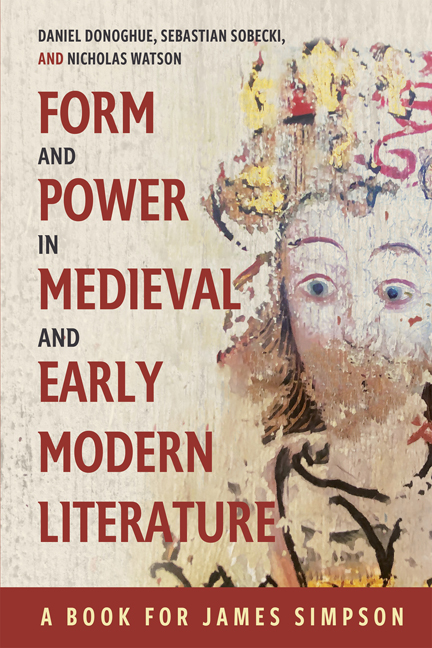Book contents
- Frontmatter
- Contents
- List of Illustrations
- Contributors and Editors
- Acknowledgments
- List of Abbreviations
- Simpson: An Interim Report
- PART I THE HERMENEUTICS OF RECOGNITION
- PART II GENRE AND FIGURE
- PART III CULTURE AND INSTITUTIONS
- PART IV REFORMATIONS
- James Simpson’s Publications from 1984 to 2024
- Bibliography
- A Note on the Bloomfield Conferences
- General Index
- Tabula Gratulatoria
7 - Filling in the Lines: Text, Image, and Late Medieval Literary Forms
Published online by Cambridge University Press: 17 May 2024
- Frontmatter
- Contents
- List of Illustrations
- Contributors and Editors
- Acknowledgments
- List of Abbreviations
- Simpson: An Interim Report
- PART I THE HERMENEUTICS OF RECOGNITION
- PART II GENRE AND FIGURE
- PART III CULTURE AND INSTITUTIONS
- PART IV REFORMATIONS
- James Simpson’s Publications from 1984 to 2024
- Bibliography
- A Note on the Bloomfield Conferences
- General Index
- Tabula Gratulatoria
Summary
James Simpson's scholarship has long been committed to the idea that “literary texts both illuminate and unsettle discursive patterns in disciplines that might seem more powerful.” These powerful alternative disciplines are generally based in language – Simpson goes on to name them as “theology, economics, psychology, politics” – but this idea might inspire questions also about the power of literary words to illuminate or unsettle discursive patterns in other media. In this essay, I will borrow the Simpsonian framework to explore how literary words engage visual media, in particular, and how visual media engage them. Do they illuminate each other? Do they unsettle each other? Which is more powerful? And what is the role of literary language, specifically, in the relation between visual and verbal representational forms?
These are questions that Simpson has also taken up in his influential work on iconoclasm. If images offer a powerful force countering the dominance of the word, iconoclasm registers the results of a contest between words and images in which words have ostensibly won. But does iconoclasm lead, also, to the development of a language that is precisely literary? Or, put another way: is the relegation of images to the sidelines necessary somehow for the development of literature? I will suggest here that it is not – that understanding late-medieval texts and images as mutually illuminating, mutually unsettling, allows us to ask how literary language emerges from an environment that includes both words and pictures. Iconoclastic discourses claim a separation of text and image that – for all its stridence – is almost always illusory. Simpson himself describes the ways in which an iconoclastic yet idolatrous poet like Milton refuses the opposition, even while the refusal causes “psychic pain.”5 But refusing the opposition between text and image is characteristic of medieval aesthetics, and seems to cause, in general, much less pain. Indeed, late medieval artifacts often reinforce the necessary reliance of one art form upon the other, illuminating and unsettling each other in a dynamic that seems less like a power struggle, perhaps, than a dance. Reading the intermedial engagements of the manuscript page counter-intuitively as an exploration of verbal form, I will suggest that some kinds of literary language in the fourteenth and fifteenth centuries developed in concert with the visual textures of literacy.
- Type
- Chapter
- Information
- Form and Power in Medieval and Early Modern LiteratureA Book for James Simpson, pp. 121 - 146Publisher: Boydell & BrewerPrint publication year: 2024



